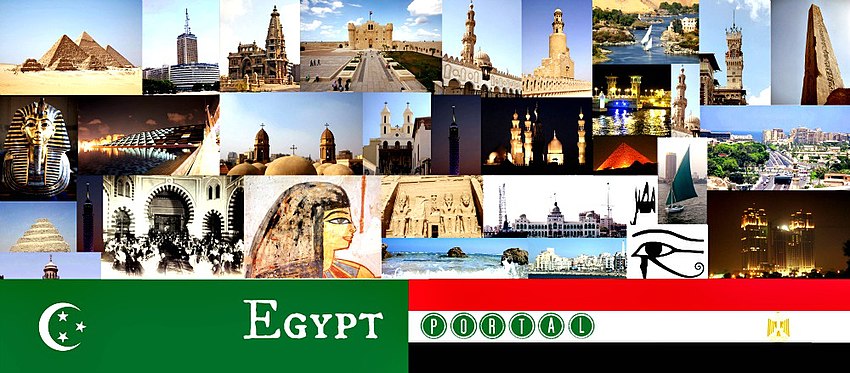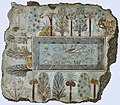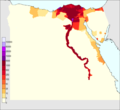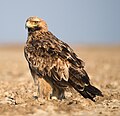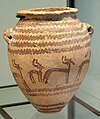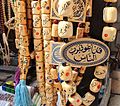The Egypt Portal
Egypt Arabic : مصر Miṣr [mesˁr] Egyptian Arabic pronunciation: [mɑsˤr] Arab Republic of Egypt , is a transcontinental country spanning the northeast corner of Africa and the Sinai Peninsula in the southwest corner of Asia . It is bordered by the Mediterranean Sea to the north , the Gaza Strip of Palestine and Israel to the northeast , the Red Sea to the east, Sudan to the south , and Libya to the west . The Gulf of Aqaba in the northeast separates Egypt from Jordan and Saudi Arabia . Cairo is the capital and largest city of Egypt , while Alexandria , the second-largest city, is an important industrial and tourist hub at the Mediterranean coast . At approximately 100 million inhabitants, Egypt is the 14th-most populated country in the world , and the third-most populated in Africa.
Egypt has one of the longest histories of any country, tracing its heritage along the Nile Delta back to the 6th–4th millennia BCE. Considered a cradle of civilisation , Ancient Egypt saw some of the earliest developments of writing, agriculture, urbanisation, organised religion and central government. Egypt was an early and important centre of Christianity , later adopting Islam from the seventh century onwards. Cairo became the capital of the Fatimid Caliphate in the tenth century, and of the Mamluk Sultanate in the 13th century. Egypt then became part of the Ottoman Empire in 1517, before its local ruler Muhammad Ali established modern Egypt as an autonomous Khedivate in 1867.
Egypt's current government, a semi-presidential republic led by president Abdel Fattah el-Sisi since he was elected in 2014, has been described by a number of watchdogs as authoritarian and responsible for perpetuating the country's poor human rights record . Islam is the official religion of Egypt, and Arabic is its official language. The great majority of its people live near the banks of the Nile River, an area of about 40,000 square kilometres (15,000 sq mi), where the only arable land is found. The large regions of the Sahara desert, which constitute most of Egypt's territory, are sparsely inhabited. About 43% of Egypt's residents live across the country's urban areas, with most spread across the densely populated centres of greater Cairo, Alexandria and other major cities in the Nile Delta. Egypt is considered to be a regional power in North Africa , the Middle East and the Muslim world , and a middle power worldwide. It is a developing country having a diversified economy, which is the largest in Africa , the 38th-largest economy by nominal GDP and 127th by nominal GDP per capita. Egypt is a founding member of the United Nations , the Non-Aligned Movement , the Arab League , the African Union , Organisation of Islamic Cooperation , World Youth Forum , and a member of BRICS . (Full article...
General images
The following are images from various Egypt-related articles on Wikipedia.
Image 1 The
Qattara Depression in Egypt's north west (from
Egypt )
Image 2 Egyptians celebrated feasts and festivals, accompanied by music and dance. (from
Ancient Egypt )
Image 3 Smart Village , a business district established in 2001 to facilitate the growth of high-tech businesses (from
Egypt )
Image 4 Female nationalists demonstrating in
Cairo , 1919 (from
Egypt )
Image 6 The
Egyptian Museum of Cairo (from
Egypt )
Image 7 The Weighing of the Heart from the
Book of the Dead of Ani (from
Egypt )
Image 9 The
Fayum mummy portraits epitomize the meeting of Egyptian and Roman cultures. (from
Ancient Egypt )
Image 10 Model of a household porch and garden,
c. 1981–1975 BC (from
Ancient Egypt )
Image 12 Soad Hosny , film star (from
Egypt )
Image 13 The Cairo Metro (line 2) (from
Egypt )
Image 14 Lower-class occupations (from
Ancient Egypt )
Image 15 The "weighing of the heart" scene from the
Book of the Dead (from
Egypt )
Image 17 Egypt's topography (from
Egypt )
Image 18 Change in per capita GDP of Egypt, 1820–2018. Figures are inflation-adjusted to 2011 International dollars. (from
Egypt )
Image 19 Four colossal statues of
Ramesses II flank the entrance of his temple
Abu Simbel . (from
Ancient Egypt )
Image 20 Anubis , the god associated with mummification and burial rituals, attending to a mummy (from
Ancient Egypt )
Image 21 British infantry near
El Alamein , 17 July 1942 (from
Egypt )
Image 22 The
Giza Necropolis is the oldest of the
ancient Wonders and the only one still in existence. (from
Egypt )
Image 23 Napoleon defeated the
Mamluk troops in the
Battle of the Pyramids , 21 July 1798, painted by
Lejeune . (from
Egypt )
Image 24 Smoke rises from oil tanks beside the
Suez Canal hit during the initial
Anglo-French assault on Egypt, 5 November 1956. (from
Egypt )
Image 26 The pharaoh was usually depicted wearing symbols of royalty and power. (from
Ancient Egypt )
Image 27 The preserved Temple of Horus at Edfu is a model of Egyptian architecture. (from
Ancient Egypt )
Image 28 Egyptian honour guard soldiers during a visit of U.S. Navy Adm. Mike Mullen (from
Egypt )
Image 29 Egyptian
tomb models as funerary goods (from
Ancient Egypt )
Image 31 Seagoing ship of an expedition to Punt, from a relief of
Hatshepsut's Mortuary temple , Deir el-Bahari (from
Ancient Egypt )
Image 32 Protesters from the Third Square movement, which supported neither the former Morsi government nor the Armed Forces, 31 July 2013 (from
Egypt )
Image 33 The gods
Osiris ,
Anubis , and
Horus in the tomb of Horemheb (
KV57 ) in the Valley of the Kings (from
Ancient Egypt )
Image 34 Rectangular fishpond with ducks and
lotus planted round with date palms and fruit trees,
Tomb of Nebamun , Thebes, 18th Dynasty (from
Ancient Egypt )
Image 35 Sennedjem plows his fields in
Aaru with a pair of oxen,
Deir el-Medina . (from
Ancient Egypt )
Image 36 The Ptolemaic Queen
Cleopatra VII and her son by Julius Caesar,
Caesarion , at the
Temple of Dendera (from
Egypt )
Image 37 A crowd at Cairo Stadium watching the
Egypt national football team (from
Egypt )
Image 38 An offshore platform in the Darfeel Gas Field (from
Egypt )
Image 39 The
Narmer Palette depicts the unification of the Two Lands. (from
Ancient Egypt )
Image 41 Painted limestone relief of a noble member of Ancient Egyptian society during the New Kingdom (from
Ancient Egypt )
Image 42 Tutankhamun's burial mask is one of the major attractions of the
Egyptian Museum of Cairo. (from
Egypt )
Image 43 Menna and Family Hunting in the Marshes, Tomb of Menna,
c. 1400 BC (from
Ancient Egypt )
Image 44 Egyptian literacy rate among the population aged 15 years and older by UNESCO Institute of Statistics (from
Egypt )
Image 45 Tourists riding an
Arabian camel in front of
Pyramid of Khafre . The
Giza Necropolis is one of Egypt's main tourist attractions. (from
Egypt )
Image 46 The
Edwin Smith surgical papyrus describes anatomy and medical treatments, written in
hieratic ,
c. 1550 BC . (from
Ancient Egypt )
Image 47 Alexandria in 2017 (from
Egypt )
Image 48 Frontispiece of
Description de l'Égypte , published in 38 volumes between 1809 and 1829 (from
Ancient Egypt )
Image 50 Ruins of Deir el-Medina (from
Ancient Egypt )
Image 51 Early tomb painting from
Nekhen ,
c. 3500 BC , Naqada, possibly Gerzeh culture (from
Ancient Egypt )
Image 52 Egypt's population density (people per km
2 ) (from
Egypt )
Image 54 Illustration of various types of capitals, by
Karl Richard Lepsius (from
Ancient Egypt )
Image 55 The
Al-Hakim Mosque in Cairo, of
Al-Hakim bi-Amr Allah , the sixth caliph, as renovated by
Dawoodi Bohra (from
Egypt )
Image 56 Cairo grew into a
metropolitan area with a population of over 20 million. (from
Egypt )
Image 57 Kushari , one of Egypt's national dishes (from
Egypt )
Image 58 Salah Zulfikar , film star (from
Egypt )
Image 60 Tutankhamun charging enemies on his
chariot , 18th dynasty (from
Ancient Egypt )
Image 61 Wooden figures of soldiers, from the tomb of nomarch
Mesehti (
11th dynasty ) (from
Ancient Egypt )
Image 62 The
Eastern Imperial Eagle is the national animal of Egypt. (from
Egypt )
Image 63 Hieroglyphs on stela in
Louvre ,
c. 1321 BC (from
Ancient Egypt )
Image 64 Temple of Derr ruins in 1960 (from
Egypt )
Image 65 The halls of Karnak Temple are built with rows of large columns. (from
Ancient Egypt )
Image 66 Measuring and recording the harvest, from the tomb of
Menna at
Thebes (Eighteenth Dynasty) (from
Ancient Egypt )
Image 67 The
Suez Canal (from
Egypt )
Image 68 Pharaohs' tombs were provided with vast quantities of wealth, such as the
golden mask from the mummy of Tutankhamun . (from
Ancient Egypt )
Image 69 Hosni Mubarak — president of Egypt from 1981 to 2011 (from
Egypt )
Image 70 Egypt is the eighth most water stressed country in the world. (from
Egypt )
Image 71 A typical
Naqada II jar decorated with gazelles (Predynastic Period) (from
Ancient Egypt )
Image 72 The
Amr ibn al-As mosque in Cairo, recognised as the oldest in Africa (from
Egypt )
Image 73 Al-Azhar Park is listed as one of the world's sixty great public spaces by the
Project for Public Spaces . (from
Egypt )
Image 74 Statues of two pharaohs of Egypt's
Twenty-Fifth Dynasty and several other
Kushite kings,
Kerma Museum (from
Ancient Egypt )
Image 75 Prominent Egyptian dissident
Alaa Abd El-Fattah was sentenced to five years of imprisonment in December 2021. (from
Egypt )
Image 76 The
Temple of Dendur , completed by 10 BC,
Metropolitan Museum of Art (New York City) (from
Ancient Egypt )
Image 77 A tomb relief depicts workers plowing the fields, harvesting the crops, and threshing the grain under the direction of an overseer, painting in the tomb of
Nakht . (from
Ancient Egypt )
Image 78 Tanoura dancers performing in Wekalet El Ghoury, Cairo (from
Egypt )
Image 80 Ancient Egyptians playing music (from
Egypt )
Image 81 Naguib Mahfouz , the first Arabic-language writer to win the
Nobel Prize in Literature (from
Egypt )
Image 82 Egyptian tanks advancing in the Sinai desert during the
Yom Kippur War , 1973 (from
Egypt )
Image 83 Hatshepsut's trading expedition to the
Land of Punt (from
Ancient Egypt )
Image 84 A figure wearing the red crown of Lower Egypt, most probably
Amenemhat II or
Senwosret II . It functioned as a divine guardian for the
imiut ; the divine kilt, suggests that the statuette was not merely a representation of the living ruler. (from
Ancient Egypt )
Image 86 Egyptian President
Gamal Abdel Nasser in Mansoura, 1960 (from
Egypt )
Image 87 Muhammad Ali was the founder of the
Muhammad Ali dynasty and the first
Khedive of Egypt and
Sudan . (from
Egypt )
Image 89 Glassmaking was a highly developed art. (from
Ancient Egypt )
Image 90 Hunting game birds and plowing a field, tomb of
Nefermaat and his wife
Itet (
c. 2700 BC ) (from
Ancient Egypt )
Image 91 The
pyramids of Giza are among the most recognizable symbols of ancient Egyptian civilization. (from
Ancient Egypt )
Image 93 The well preserved Temple of Isis from
Philae is an example of
Egyptian architecture and
architectural sculpture . (from
Ancient Egypt )
Image 94 Coffin of Khnumnakht in 12th dynasty style, with palace facade, columns of inscriptions, and two Wedjat eyes (from
Ancient Egypt )
Image 95 Green irrigated land along the Nile amidst the desert and in the delta (from
Egypt )
Image 96 President el-Sisi with US President
Joe Biden , 11 November 2022 (from
Egypt )
Image 98 Egypt under Muhammad Ali dynasty (from
Egypt )
Image 99 Arabic calligraphy has seen its golden age in
Cairo . This adornment and beads being sold in
Muizz Street (from
Culture of Egypt )
Image 100 The
Book of the Dead was a guide to the deceased's journey in the afterlife. (from
Ancient Egypt )
Image 101 Khafre enthroned (from
Ancient Egypt )
Image 103 The High Court of Justice in
Downtown Cairo (from
Egypt )
... that the largest intact Ancient Egyptian tomb ever found
... that the Qurna Queen 's tomb may be the only complete royal burial exported in its entirety from Egypt?
... that when King Hugh III of Cyprus force a marriage on his vassal, Lady Isabella of Beirut , the Egyptian sultan Baibars declared himself her protector?
... that the sarcophagus of Eshmunazar II king of Sidon , is one of only three ancient Egyptian sarcophagi unearthed outside Egypt?
... that Spanish diplomat Ángel Sagaz Zubelzu descended from expelled Jews and thus entitled to Spanish citizenship ?
... that although the Kepler triangle Great Pyramid of Giza , the triangle's connection to the golden ratio makes it unlikely to have been used in ancient Egypt?
... that while Egypt has the Order of the Nile, Sudan has the Order of the Two Niles White and Blue ?
... that in 2022 an Egyptian company was awarded the contract to build the first toll highway in Madagascar
Faten Ahmed Hamama Egyptian Arabic : فاتن حمامه pronounced [ˈfæːten ħæˈmæːmæ] ⓘ film and television actress and film producer . She was the first wife of Ezz El-Dine Zulficar . She made her screen debut in 1939, when she was only seven years old. Her earliest roles were minor, but her activity and gradual success helped to establish her as a distinguished Egyptian actress. Later revered as an icon in Egyptian cinema . In 1996, nine of the films she starred in were included in the Top hundred films in the history of Egyptian cinema by the cinema critics of Cairo International Film Festival .
After a seven-year hiatus from acting, Hamama returned in 2000 in what was a much anticipated television series,
Wageh El Amar (وجه القمر,
Face of the Moon ). Hamama substantially helped in improving the cinema industry in Egypt and emphasizing the importance of women in cinema and Egyptian society. In 2000, she was selected as Star of the Century by the Egyptian Writers and Critics organization. (
Full article... )
List of selected biographies
Feteer meshaltet in Egypt
Feteer meshaltet (
Egyptian Arabic :
فطير مشلتت [fɪˈtˤiːr meˈʃæltet] , literally "cushioned pies" or "cushion-like pies"), often simply referred to as
meshaltet (
مشلتت ), is a flaky
Egyptian layered pastry. It consists of many thin layers of dough and ghee and an optional filling. The fillings can be both sweet or savory. Sweet fillings may include cheese, coconut,
mehalabiya ,
malban , Nutella or chocolate, while savory fillings can be anything from ground beef to sausage or cheese. Plain
meshaltet is usually soaked in
honey and spread with
jam or cheese or served with
olives . Because of its versatility,
meshaltet is often referred to as an Egyptian
pizza . (
Full article... )
Related portals
Religions in Egypt
Arab states
Other countries
WikiProjects
More did you know...
... that the Abu Haggag Mosque Luxor Temple , making it the oldest building in the world continuously in use?
Egypt topics
NC - Non-consecutive terms; Bold - Current
Beverages
Non-alcoholic beverages Alcoholic beverages
Breads Appetizers Cheeses Soups Dishes Grilled meats Desserts Common ingredients
Related cuisines
Official language Spoken Arabic dialects Historical languages Minority languages Foreign languages Immigrant minority languages Sign languages
Public institutions National institutions Private institutions
Categories
Category puzzle Select [►] to view subcategories
New articles
This list was generated from
these rules . Questions and feedback
are always welcome ! The search is being run daily with the most recent ~14 days of results.
Note: Some articles may not be relevant to this project.
Rules | Match log | Results page (for watching) | Last updated: 2024-07-17 20:22 (UTC)
Note : The list display can now be customized by each user. See List display personalization for details.
Khashaba (edit | talk | history | links | watch | logs | tools )WikiOriginal-9 (talk · contribs · new pages (818) Mishal (place) (edit | talk | history | links | watch | logs | tools )Lahsim Niasoh (talk · contribs · new pages (15) Hady (edit | talk | history | links | watch | logs | tools )WikiOriginal-9 (talk · contribs · new pages (818) Baroque in Milan (edit | talk | history | links | watch | logs | tools )Cerebellum (talk · contribs · new pages (59) Background to the Israel-Hamas war (edit | talk | history | links | watch | logs | tools )Makeandtoss (talk · contribs · new pages (3) Hussein Sabri Pasha (edit | talk | history | links | watch | logs | tools )Caesarion8 (talk · contribs · new pages (2) Water polo at the 1959 Mediterranean Games (edit | talk | history | links | watch | logs | tools )Tbennert (talk · contribs · new pages (7) List of defunct restaurants in Portland, Oregon (edit | talk | history | links | watch | logs | tools )Another Believer (talk · contribs · new pages (123) Wildlife of the Levant (edit | talk | history | links | watch | logs | tools )Magedsaleh392 (talk · contribs · new pages (19)
Things you can do
Associated Wikimedia
The following Wikimedia Foundation sister projects provide more on this subject:
Commons
Wikibooks
Wikidata
Wikinews
Wikiquote
Wikisource
Wikispecies
Wikiversity
Wikivoyage
Wiktionary
External media
More portals

